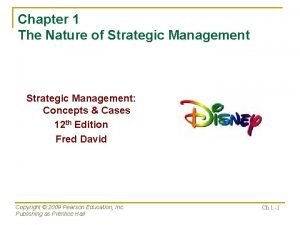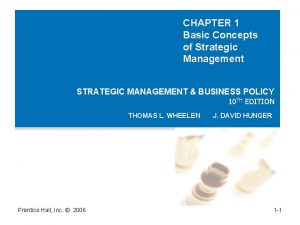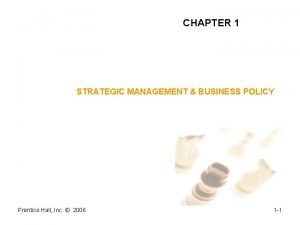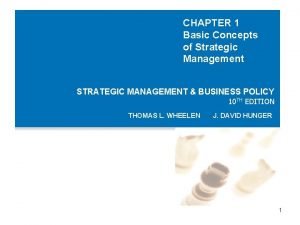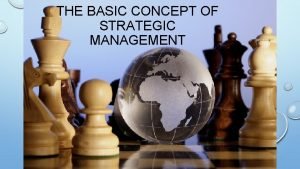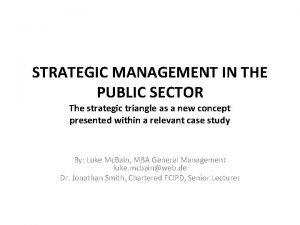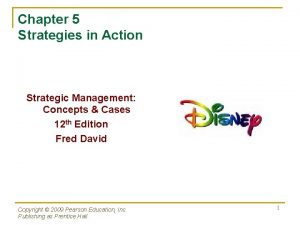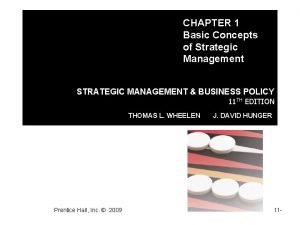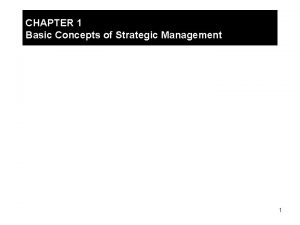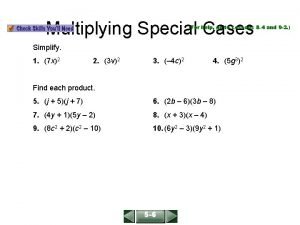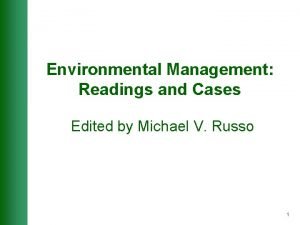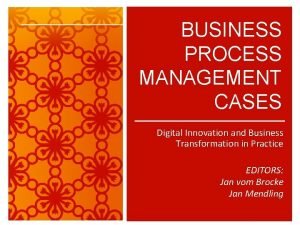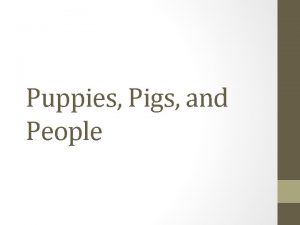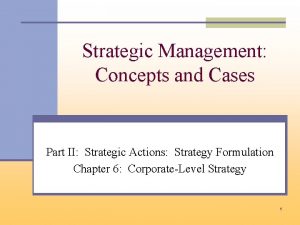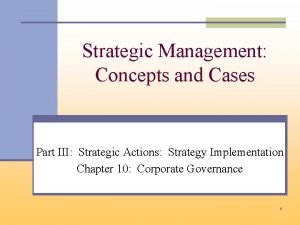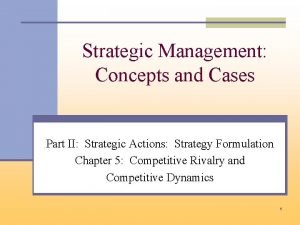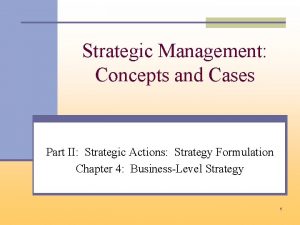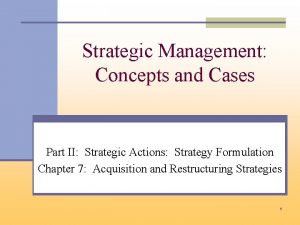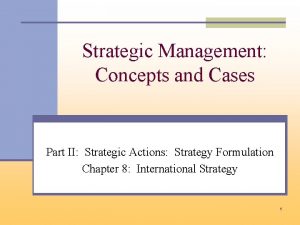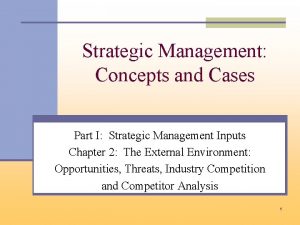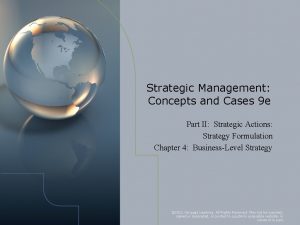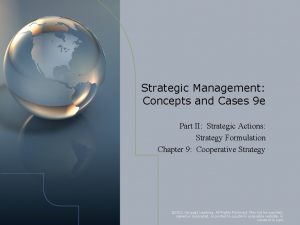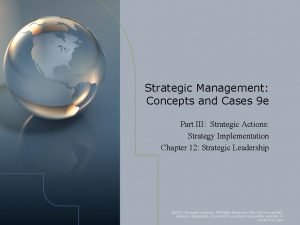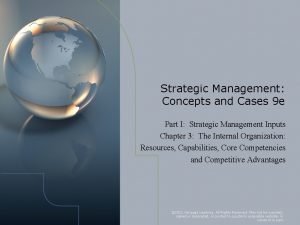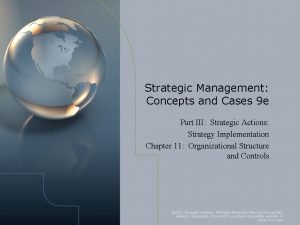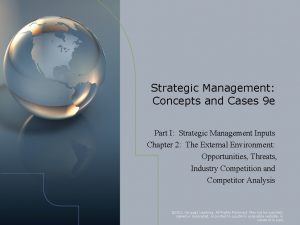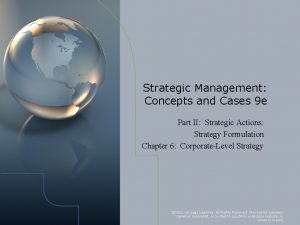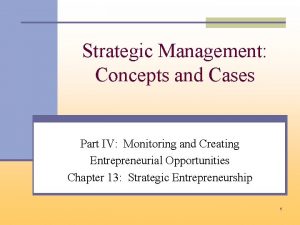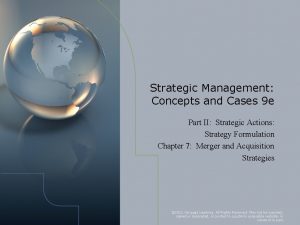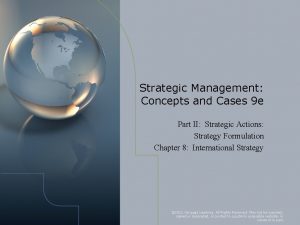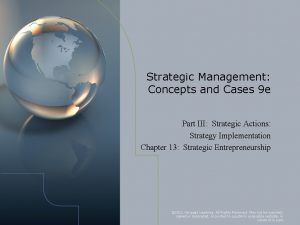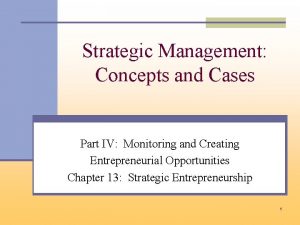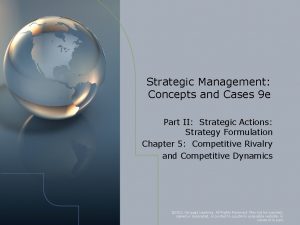Strategic Management Concepts and Cases Part I Strategic























- Slides: 23

Strategic Management: Concepts and Cases Part I: Strategic Management Inputs Chapter 3: The Internal Organization: Resources, Capabilities, Core Competencies and Competitive Advantages 1

The Strategic Management Process 2

Chapter 3: The Internal Organization: Resources, Capabilities, Core Competencies and Competitive Advantages n Overview: Eight content areas n Importance of understanding internal organization n Value: Definition and importance n Tangible vs intangible resources n Capabilities: Definition and development n Core competencies: Criteria (N=4) n Value Chain Analysis n Outsourcing: Definition and “why? ” n Importance of internal organization assessment 3

Innovation vs. Efficiency: 3 M n Diversified technology into 6 business segments n Historically: Commitment to innovation n n Slogan: The Spirit of Innovation. That’s 3 M. Relied on skills of scientists and engineers Historically 1/3 annual sales from products introduced into marketplace in most recent 5 yrs. 30 -plus core technologies basis for > 55, 000 products Changing times: by mid-2007 only 25% sales earned from products introduced over previous 5 yrs – why? 4

Innovation vs. Efficiency: 3 M (Cont’d) n …Leadership n CEO Mc. Nerney (formerly of GE) implemented Six. Sigma, a management technique to decrease product defects and increase efficiency n Six Sigma doesn’t lend itself to creativity / innovation, something imperative in the R&D arena n Six Sigma n n Focuses on actions to define, measure, analyze, improve and control – efficiency Efficiency vs. innovation – it’s one or the other! n New CEO Buckley – a reenergization of R&D 5

Chapter 3: The Internal Organization: Resources, Capabilities, Core Competencies and Competitive Advantages n Overview: Eight content areas n Importance of understanding internal organization n Value: Definition and importance n Tangible vs intangible resources n Capabilities: Definition and development n Core competencies: Criteria (N=4) n Value Chain Analysis n Outsourcing: Definition and “why? ” n Importance of internal organization assessment 6

Analyzing the Internal Organization (IO) n Context of Internal Analysis n Creating Value n The Challenge of Analyzing the IO 7

Analyzing the Internal Organization (IO) (Cont’d) n Context of Internal Analysis n ‘Global mind-set’ n n Analyze firm’s portfolio of resources and bundle heterogeneous resources and capabilities n n Ability to study an internal environment in ways that do not depend on the assumptions of a single country, culture, or context Understand how to leverage these bundles An organization's core competencies creates and sustains its competitive advantage n Creating Value n The Challenge of Analyzing the IO 8

Components of Internal Analysis Leading to Competitive Advantage and Strategic Competitiveness 9

Analyzing the Internal Organization (IO) (Cont’d) n Context of Internal Analysis n Creating Value n n Exploit core competencies or competitive advantage Value: measured by a product's performance characteristics and by its attributes for which customers are willing to pay n The Challenge of Analyzing the IO 10

Analyzing the Internal Organization (IO) (Cont’d) n Context of Internal Analysis n Creating Value n The Challenge of Analyzing the IO n Strategic decisions are non-routine, have ethical implications and influence the organization’s above-average returns n n Managers face uncertainty on many fronts -n n Involves identifying, developing, deploying and protecting firms’ resources, capabilites and core competencies Proprietary technologies Changes in economic and political trends, societal values and shifts in customer demands Environment – increases complexity Intraorganizational conflict n Due to decisions about core competencies and how to nurture them 11

Conditions Affecting Managerial Decisions About Resources, Capabilities, and Core Competencies 12

Chapter 3: The Internal Organization: Resources, Capabilities, Core Competencies and Competitive Advantages n Overview: Eight content areas n Importance of understanding internal organization n Value: Definition and importance n Tangible vs. intangible resources n Capabilities: Definition and development n Core competencies: Criteria (N=4) n Value Chain Analysis n Outsourcing: Definition and “why? ” n Importance of internal organization assessment 13

Resources, Capabilities and Core Competencies n Competitive Advantage (CA) foundation includes n Resources n n n Capabilities n n n Bundles to created organizational capabilities Tangible and intangible (As seen in Figure 3. 1) Source of a firm’s core competencies and basis for CA Purposely integrated to achieve a specific task/set of tasks Core Competencies n n Capabilities that serve as a source of CA for a firm over its rivals Distinguish a company from its competitors – the personality 14

Resources, Capabilities and Core Competencies n Tangible n n n Assets that can be seen, touched and quantified Examples include equipment, facilities, distribution centers, formal reporting structures Four specific types n Intangible n n Assets rooted deeply in the firm’s history, accumulated over time In comparison to ‘tangible’ resources, usually can’t be seen or touched Examples include knowledge, trusts, organizational routines, capabilities, innovation, brand name, reputation 15 Three specific types

Chapter 3: The Internal Organization: Resources, Capabilities, Core Competencies and Competitive Advantages n Overview: Eight content areas n Importance of understanding internal organization n Value: Definition and importance n Tangible vs. intangible resources n Capabilities: Definition and development n Core competencies: Criteria (N=4) n Value Chain Analysis n Outsourcing: Definition and “why? ” n Importance of internal organization assessment 16

Building Core Competencies: Criteria and Value Chain Analysis n Two tools firms use to identify and build on their core competencies Four specific criteria of Sustainable CA n Value Chain Analysis n 17

Building Core Competencies: Criteria and Value Chain Analysis n Four specific criteria of Sustainable CA n n Valuable Rare Costly-to-imitate Nonsubstitutable capabilities n Competitive consequences include n Disadvantage, parity, temporary advantage and sustainable advantage n Performance implications include returns n Above, below or average 18

Building Core Competencies: Criteria and Value Chain Analysis n Primary activities n Involved with product’s physical creation, sales and distribution to buyers, and service after the sale § Service, marketing/sales, outbound/inbound logistics and operations n Support activities n n Provide assistance necessary for the primary activities to take place Includes firm infrastructure, HRM, technologies development and procurement 19

The Basic Value Chain 20

Chapter 3: The Internal Organization: Resources, Capabilities, Core Competencies and Competitive Advantages n Overview: Eight content areas n Importance of understanding internal organization n Value: Definition and importance n Tangible vs. intangible resources n Capabilities: Definition and development n Core competencies: Criteria (N=4) n Value Chain Analysis n Outsourcing: Definition and “why? ” n Importance of internal organization assessment 21

Outsourcing n Definition: Purchase of a value-creating activity from an external supplier n n n Effective execution includes an increase in flexibility, risk mitigation and capital investment reduction Trend continues at a rapid pace Firms must outsource activities where they cannot create value or are at a substantial disadvantage compared to competitors n Can cause concerns n Usually revolves around innovative ability and loss of jobs 22

Competencies, Strengths, Weaknesses and Strategic Decisions n Firms must identify their strengths and weaknesses n Appropriate resources and capabilities needed to develop desired strategy and create value for customers/other stakeholders n Tools (I. e. , outsourcing) can help a firm focus on core competencies as the source for CA n Core competencies have potential to become core rigidities n Competencies emphasized when no longer competitively relevant can become a weakness n External environmental conditions and events impact a firm’s core competencies 23
 Criminal cases vs civil cases
Criminal cases vs civil cases Business ethics and strategic management
Business ethics and strategic management Basic concepts of strategic management
Basic concepts of strategic management Basic concepts of strategic management
Basic concepts of strategic management Basic concept of strategic management
Basic concept of strategic management Basic concepts of strategic management
Basic concepts of strategic management Political management in strategic triangle
Political management in strategic triangle Strategies in action
Strategies in action Strategic management decision making process
Strategic management decision making process Basic concept of strategic management
Basic concept of strategic management Resource based model
Resource based model Cultural aspects of strategy choice
Cultural aspects of strategy choice Lesson 9: multiplying polynomials
Lesson 9: multiplying polynomials Analyzing accounting concepts and practices chapter 2
Analyzing accounting concepts and practices chapter 2 Environmental management: readings and cases
Environmental management: readings and cases Business process management cases
Business process management cases Pretend techniques in strategic family therapy
Pretend techniques in strategic family therapy Tirole
Tirole Puppies pigs and people
Puppies pigs and people Part part whole addition
Part part whole addition Part to part ratio definition
Part to part ratio definition Part part whole
Part part whole What is a technical description
What is a technical description Different parts of the bar
Different parts of the bar

